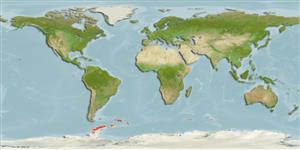>
Perciformes/Notothenioidei (Icefishes) >
Nototheniidae (Cod icefishes) > Nototheniinae
Etymology: Gobionotothen: Latin, gobius = gudgeon + see under Notothenia; gibberifrons: gibberifrons from Latin giber a hump, frons forehead, humped forehead (Ref. 11892).
More on author: Lönnberg.
Environment: milieu / climate zone / depth range / distribution range
Ökologie
seewasser demersal; tiefenbereich 6 - 429 m (Ref. 11892). Polar; 53°S - 67°S, 75°W - 75°E
Southern Ocean: Scotia Arc and Heard Island. Also distributed in the South Atlantic, near the southern Shetland, southern Sandwich, southern Orkney Islands, and near South Georgia Island (Ref. 4883).
Length at first maturity / Size / Gewicht / Alter
Maturity: Lm 37.7 range ? - ? cm
Max length : 55.0 cm TL Männchen/unbestimmt; (Ref. 5179); common length : 40.0 cm TL Männchen/unbestimmt; (Ref. 2121)
Rückenflossenstacheln (insgesamt): 6 - 8; Rückenflossenweichstrahlen (insgesamt): 31-34; Afterflossenweichstrahlen: 31 - 34. Upper part of head and body irregularly spotted and blotched. Rarely with traces of darker cross-bars, young with irregular cross-bars, broken up into three or four series of alternating spots (Ref. 11892).
Mature females may spawn for the first time from around 6-8 years of age (Ref. 71843).
Dewitt, H.H., P.C. Heemstra and O. Gon, 1990. Nototheniidae. p. 279-331. In O. Gon and P.C. Heemstra (eds.) Fishes of the Southern Ocean. J.L.B. Smith Institute of Ichthyology, Grahamstown, South Africa. (Ref. 5179)
IUCN Rote Liste Status (Ref. 130435)
Bedrohung für Menschen
Harmless
Nutzung durch Menschen
Fischereien: weniger kommerziell
Mehr Information
PartnerBilderStamps, Coins Misc.LauteCiguateraGeschwindigkeitSchwimmstilKiemenoberflächeOtolithsGehirngrößeSehfähigkeit
Tools
Zusatzinformationen
Download XML
Internet Quellen
Estimates based on models
Preferred temperature (Ref.
123201): -1.3 - 0.7, mean -0.6 °C (based on 36 cells).
Phylogenetic diversity index (Ref.
82804): PD
50 = 0.5312 [Uniqueness, from 0.5 = low to 2.0 = high].
Bayesian length-weight: a=0.00407 (0.00344 - 0.00483), b=3.24 (3.19 - 3.29), in cm total length, based on LWR estimates for this species (Ref.
93245).
Trophic level (Ref.
69278): 3.3 ±0.2 se; based on diet studies.
Widerstandsfähigkeit (Ref.
120179): niedrig, Verdopplung der Population dauert 4,5 - 14 Jahre. (Fec=21,699; tm=10).
Fishing Vulnerability (Ref.
59153): Moderate vulnerability (42 of 100).
Climate Vulnerability (Ref.
125649): Moderate to high vulnerability (46 of 100).
Nutrients (Ref.
124155): Calcium = 19.7 [11.5, 46.6] mg/100g; Iron = 0.384 [0.181, 0.754] mg/100g; Protein = 17.7 [15.5, 19.6] %; Omega3 = 0.329 [0.180, 0.572] g/100g; Selenium = 16.6 [7.0, 41.1] μg/100g; VitaminA = 12.4 [2.7, 59.6] μg/100g; Zinc = 0.497 [0.332, 0.747] mg/100g (wet weight); based on
nutrient studies.
